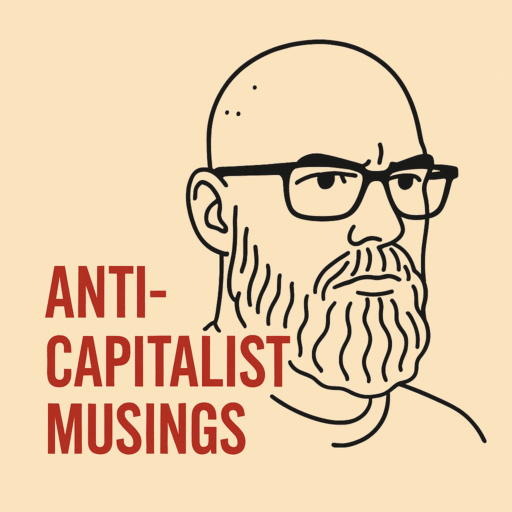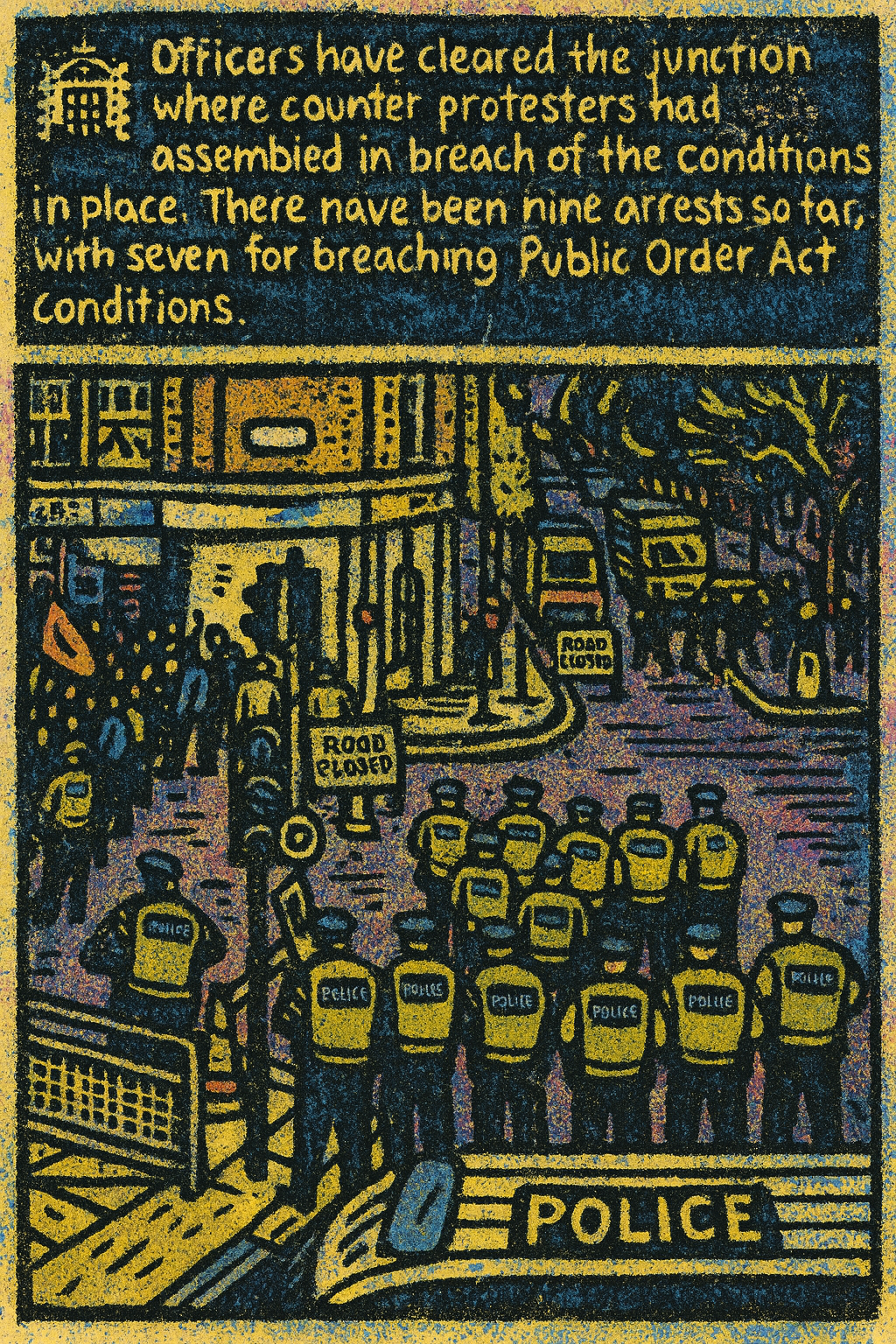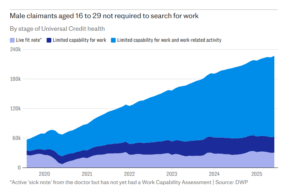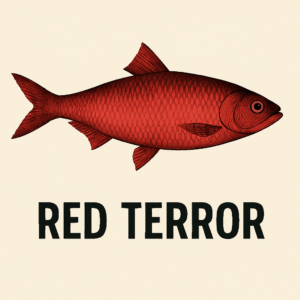Englands’s Far Right Summer
You can smell the staging from here. In Islington, Afghan men blow kisses from the windows of a migrant hotel, and the Daily Mail runs the image on repeat, the caption doing the work of a thousand dog whistles: “asylum seekers film and laugh while protests erupt below” (Mail, 30 July 2025). In Epping, rival protests flare, and Sky News lingers on the “jeering crowds” as if documenting a sporting derby, noting only in passing that the event had been seeded on social media days earlier by far-right agitators (Sky, 29 July 2025). In Warwickshire, a single alleged crime becomes national news: “Afghan asylum seekers charged with rape,” blares the Mail’s headline, without context, before any trial, before any facts have settled.
This is the pattern. Local tensions (real or inflamed) are whipped into moral crisis by a press that knows precisely what it is doing. The Express offers rolling live coverage of “migrant protests” as if documenting an unfolding civil war, while far-right influencers pose for selfies outside hotels (Express, 28 July 2025). The language is euphemistic “residents concerned”, “protesters want their voices heard” but the choreography is unmistakable. The camera turns on the migrants and stays there.
The New Statesman sees the arc more clearly. One year on, tensions still circle Britain’s asylum-seeker hotels not because the situation is unresolved, but because the narrative has been reloaded for summer. As Anoosh Chakelian notes, “Riots in Southport and Ballymena over the past two years had the same trigger: charges of attacks on young girls … disinformation that led to rioters attacking a mosque and setting an asylum hotel on fire” (New Statesman, 26 July 2025). Another piece warns that in post-industrial towns abandoned by Westminster, “apathy is no longer passive. It has curdled into rage” (New Statesman, 2 August 2025). The far right offers an answer, ugly but direct. The government offers nothing. And the press is already on location.
Spectacle, Staged
The migrant hotel is not new. What’s new is the choreography. Each confrontation outside a hotel is treated not as an aberration, but as a recurring drama in a long-running series. The Daily Mail’s 30 July coverage of Islington reads like theatre review: “Residents clashed with counter-protesters as some migrants were seen filming and laughing”. Sky News complements the script, noting the “blowing of kisses” as a flashpoint that triggered the crowd. There is a logic here, and it is not random: the media alights not on policy, not on housing precarity or legal limbo, but on affect, expressions, gestures, provocations. The story is not the structural cause, but the symbolic insult.
The staging is deliberate. Protesters arrive with banners, sound systems, and slogans pre-packaged by Telegram channels and Facebook pages run by far-right activists. Tommy Robinson reappears, sunburned and smug, jetting in from Spain like a nationalist consultant. He doesn’t live the life; he tours it. He arrives when the spectacle peaks and vanishes before the arrests are made. The target might be the asylum seeker this week. But the theatre is what matters. Cameras are ready. Counter-protesters are baited. Local police are trapped between containment and performance.
The Express streamlines the tension into ticker updates: “LIVE: Migrant protests erupt again.” But nothing has really erupted. It is manufactured consent for a reactionary politics, designed to fill the ideological vacuum Labour has left wide open. Starmer’s government, with its commitment to pragmatism over principle, offers no counter-narrative. Even Yvette Cooper’s long-delayed Orgreave inquiry lands not as a defence of working-class truth, but as a technocratic gesture. Into that void pours rage,
selective,
racialised,
and relentless.
The Press Is the Platform
What the press now performs is not journalism but ventriloquism. Far-right talking points filter into mainstream outlets, sometimes word-for-word. Protest leaflets become Express bullet points. A photo of a migrant at a window becomes front-page bait for an invented insult. In the Daily Mail’s coverage of the Islington standoff, the migrant is both subject and object. His expression read as mockery, his presence as threat, his very breath a political affront. The article doesn’t ask who he is. It doesn’t need to. The image does the work.
This is a kind of narrative outsourcing. The media no longer needs to invent the moral panic; it just amplifies and aestheticises it. Stories are framed through emotive visuals, the “jeering,” “taunting,” and “laughing” that convert a logistical question (housing asylum seekers) into a symbolic one (defending the nation). A migrant smirking becomes a stand-in for government failure, white disempowerment, and moral decline.
This isn’t new. The same outlets that stoked fear of Romanians and Bulgarians in 2014, Syrians in 2015, and Albanians in 2022 now circle around the Afghan, the Eritrean, the Somali man in the hotel window. Their individual stories don’t matter. The press collapses them into a single shape: the unwanted other. The New Statesman called it a “political spectacle”; that’s generous. It is ideology on auto-repeat, a theatre of resentment in high definition.
Labour’s Vacuum
What makes this summer different is that the spectacle now unfolds under a Labour government. A government that knows better, that campaigned on competence, and that has responded with silence or distance. Yvette Cooper may talk of “managed migration,” but in places like Mansfield, Epping, or Knowsley, the question isn’t migration policy. It’s abandonment. And Starmer’s Labour offers little beyond managerial discipline and evasive statements. There is no message, no narrative, no solidarity, just procedural drift.
The cost is plain. In former coal towns, the New Statesman notes, “apathy is no longer passive—it has curdled into rage.” That rage is being rerouted. Not toward landlords or bosses or private equity firms buying up housing stock, but toward the people with no power at all. Migrants. In the absence of class politics, culture war fills the frame. And Labour, terrified of saying the wrong thing, says nothing. Into that void steps the right and far right, with answers, however cruel, and a story to tell.
Worse still, the Labour government has already revealed its authoritarian instincts. The proscription of Palestine Action was not a legal technicality, it was a political decision, a signal that resistance to state-aligned violence abroad would be treated as extremism at home. Now we learn that Morgan McSweeney, Labour’s election mastermind and chief strategist, has commissioned a paper from the Tony Blair Institute on reintroducing digital ID cards. Cast your mind back to peak Blairism: mass surveillance, anti-terror legislation, and biometric authoritarianism disguised as progress. Now here is the architect again, brought in to retrofit Starmerism with the tools of technocratic control.
If this is how Labour governs (with fear of its own shadow and an allergy to principle) it will not only lose the argument. It will lose the moment. The far right is already building its movement, one staged protest at a time. The press is their co-conspirator. And the government, once again, is their bystander.
The New Face of an Old Threat
In the absence of serious government, we are left with spectacle. No statesman steps forward. No national figure makes a reasoned case. The vacuum is filled by men who thrive on noise: Farage, Robinson, Golding. Their message isn’t new. It’s a reheated stew of moral panic, racial grievance, and border fetishism. But now their reach is amplified, their platform upgraded. Where once the likes of John Tyndall or Nick Griffin of the National Front and BNP were rightly ostracised, today’s avatars of hate are invited onto GB News, quoted in the Mail, treated as men with a point, even if that point is wrapped in spittle and venom.
The knuckle-draggers of the old far right never went away. They just learned to clean up. Golding wears a suit now. Farage sips pints with studio lighting. Tommy Robinson livestreams in HD, monetised in real time. Their followers might still chant the old slogans, but their leaders have PR strategies. And most damning of all, the press plays along. Griffin once repulsed the media establishment; now his rhetorical inheritors are part of it.
Why? Because they flatter a deeper narrative. One where the country is “full,” where borders are “broken,” where “our way of life” is under threat. These are not facts, they are fictions with sponsors. And they offer an illusion of agency to those abandoned by both capital and the state. Farage tells them their enemy is the dinghy, not the dividend. Robinson says the migrant, not the mortgage company. Golding gives them scapegoats with leaflets, not answers.
Oh, and the press, desperate for clicks and contemptuous of truth, gives them space. Space Tyndall and Griffin could only have dreamed of.
The Real Story
The real story (rarely reported, and never headlined) is that counter-protests still outnumber the far right. However much the Mail and Express want to frame pro-migrant demonstrators as the new “enemy within,” it’s their side that turns up in smaller numbers, draped in Union Jacks and St George’s Crosses like makeshift uniforms of imagined sovereignty. And let’s not forget the masks and balaclavas. Wear one at a Palestine demo and you can expect the full wrath of a Telegraph columnist demanding your arrest; wear one as a far-right agitator and suddenly it’s just a touch of cold or camera shyness. The double standard isn’t subtle, it’s structural. The real enemy within writes for the Mail, gets quoted in the Telegraph and shapes the story before it’s even told.
The Summer Script
What we’re living through isn’t an explosion of spontaneous protest. It’s an annual newspaper production. Each protest, each clash, each carefully framed tabloid image is another act in a story that has been rehearsed for years: the white working class as besieged, the migrant as invader, the government as traitor. It is the same story Farage told with a white van, the same story Robinson tells with a livestream, the same story the Mail tells with a photograph of a man smiling in the wrong postcode.
But the power of this narrative isn’t in its truth. It’s in its repetition. By the time the facts arrive (if they arrive, they often don’t) they’re irrelevant. The spectacle has already done its work. This is the genius of the far right’s summer strategy: it doesn’t seek resolution. It thrives on standoff, ambiguity, and affect. It wants protest without politics, rage without reflection, nationalism as vibes.
The tragedy is not that there’s been no resistance, there has, and lots of it. Counter-protests have met the far right in the streets, often outnumbering them, despite the press trying to frame anti-fascists and pro-migrant demonstrators as the real threat. But this resistance has been left to activists, locals, and community groups while the institutions that should be holding the line (the government, the opposition, the press) either look away or quietly applaud the other side from the sidelines. The government remains inert. The opposition party is the government. And the press continues to churn out the panic, feeding a narrative they helped construct.
There is still time to intervene. But it would require the left. Not just individuals, but parties, trade unions, and cultural institutions, to stop chasing neutrality, stop hoping it will all blow over, and start naming the war being waged in plain sight. This isn’t about hotels. It’s about hegemony. And when the police do light the blue touch paper (when violence erupts, when something finally breaks) it won’t be blamed on the balaclava-clad agitators of the far right. It will be blamed on “small boats.” The enemy will be the migrant, not the mob.
This is the script. And right now, the other side is writing it.




